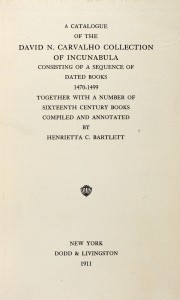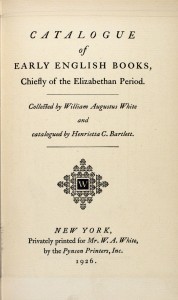In an age of inter-connectivity, mobility, and Librarything.com that purports to bring us together in a digital utopia, whither will the truly personal library go? Do we risk having a network of Gatsbys present and past, interested in books more essential for their social value than their literary or historical merit? A social networking database of personal libraries like Librarything.com purports to make the private library available for public consumption and communication. But what it might neglect to do is convey the private individual, or even the individual books, represented in its own tagged catalog. While tags allow for facile bibliophilic social networking, they may fail to describe in depth the specifics of a private library. (Click here for criticisms of the database that have trickled in from the ranks of professional librarians.)
AAS’s curator of graphic arts, Lauren Hewes, noted in two previous posts that AAS houses a wonderful collection of bookmarks and other ephemera able to shed light on the personality of a book and its owner. AAS also has a rather substantial Private Library (PL) collection, the cataloging for which often sheds substantial light on books, their owners, and their libraries. Cataloging done by the likes of Shakespeare bibliographer Henrietta C. Bartlett is just one example of the lengths to which one bibliographer went in order to detail two private libraries in the early twentieth century.
 In 1911, Bartlett published a catalog of the library of the handwriting and ink analyst David N. Carvalho, showcasing Carvalho’s collection of incunabula while advertising its selling price of $10,000. (Carvalho’s library actually sold for $1, 385.95 in 1917, far under the asking price. But Bartlett’s work served to bring together the Carvalho collection and reveal its uniqueness before its dispersal.) Henrietta Bartlett would go on to catalog William Augustus White’s library only a year before his death on May 27, 1927. White’s family consequently donated his library, giving the first folio of Shakespeare to Princeton and 88 books, including a second edition of “Romeo and Juliet,” to Harvard. Bartlett’s catalog of Carvalho’s library, and later of W.A. White’s library of early English books, reveals a cataloger engaged with her collection—down to its manuscript ink notes for Carvalho and historical miscellany for White.
In 1911, Bartlett published a catalog of the library of the handwriting and ink analyst David N. Carvalho, showcasing Carvalho’s collection of incunabula while advertising its selling price of $10,000. (Carvalho’s library actually sold for $1, 385.95 in 1917, far under the asking price. But Bartlett’s work served to bring together the Carvalho collection and reveal its uniqueness before its dispersal.) Henrietta Bartlett would go on to catalog William Augustus White’s library only a year before his death on May 27, 1927. White’s family consequently donated his library, giving the first folio of Shakespeare to Princeton and 88 books, including a second edition of “Romeo and Juliet,” to Harvard. Bartlett’s catalog of Carvalho’s library, and later of W.A. White’s library of early English books, reveals a cataloger engaged with her collection—down to its manuscript ink notes for Carvalho and historical miscellany for White.
 Each uncut page, stain, and note is noted in detail. Both of these catalogs, and many more, are housed AAS’s private libraries collection. The painstaking effort Bartlett put into her work, both for the private library catalogs and her own bibliographical endeavors, reiterates that serious bibliographic work forces us to open our books, examine uncut pages, and catalog. When confronted with questions of what makes a library—its books, its catalog, its room, its users, its owner—we wonder just what makes a library personal in a new digital age.
Each uncut page, stain, and note is noted in detail. Both of these catalogs, and many more, are housed AAS’s private libraries collection. The painstaking effort Bartlett put into her work, both for the private library catalogs and her own bibliographical endeavors, reiterates that serious bibliographic work forces us to open our books, examine uncut pages, and catalog. When confronted with questions of what makes a library—its books, its catalog, its room, its users, its owner—we wonder just what makes a library personal in a new digital age.
Further Reading:
McKenzie, D.F. Bibliography and the Sociology of Texts. New York: Cambridge University Press, 1999.
Spadoni, Carl and David Harley. “Bertrand Russell’s Library.” The Journal of Library History 20, no. 1 (1985): 25-45.

One thought on “Private Libraries in a Digital Age”